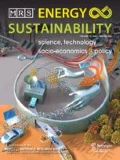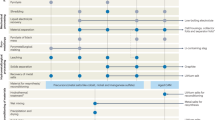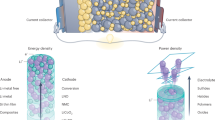Abstract
A scalable battery recycling strategy to recover and regenerate solid electrolytes and cathode materials in spent all solid-state batteries, reducing energy consumption and greenhouse gases.
With the rapidly increasing ubiquity of lithium-ion batteries (LIBs), sustainable battery recycling is a matter of growing urgency. The major challenge faced in LIB sustainability lies with the fact that the current LIBs are not designed for recycling, making it difficult to engineer recycling approaches that avoid breaking batteries down into their raw materials. Thus, it is prudent to explore new approaches to both fabricate and recycle next-generation batteries before they enter the market. Here, we developed a sustainable design and scalable recycling strategy for next-generation all solid-state batteries (ASSBs). We use the EverBatt model to analyze the relative energy consumption and environmental impact compared to conventional recycling methods. We demonstrate efficient separation and recovery of spent solid electrolytes and electrodes from a lithium metal ASSB and directly regenerate them into usable formats without damaging their core chemical structure. The recycled materials are then reconstituted to fabricate new batteries, achieving similar performance as pristine ASSBs, completing the cycle. This work demonstrates the first fully recycled ASSB and provides critical design consideration for future sustainable batteries.







Similar content being viewed by others
References
Diouf B. and Pode R.: Potential of lithium-ion batteries in renewable energy. Renew. Energy 76, 375–380 (2015).
Qiao Q., Zhao F., Liu Z., and Hao H.: Electric vehicle recycling in China: Economic and environmental benefits. Resour. Conserv. Recycl. 140, 45–53 (2019).
Harper G., Sommerville R., Kendrick E., Driscoll L., Slater P., Stolkin R., Walton A., Christensen P., Heidrich O., Lambert S., Abbott A., Ryder K., Gaines L., and Anderson P.: Recycling lithium-ion batteries from electric vehicles. Nature 575, 75–86 (2019).
Wang X., Gaustad G., Babbitt C.W., and Richa K.: Economies of scale for future lithium-ion battery recycling infrastructure. Resour. Conserv. Recycl. 83, 53–62 (2014).
Li L., Zhang X., Li M., Chen R., Wu F., Amine K., and Lu J.: The recycling of spent lithium-ion batteries: A review of current processes and technologies. Electrochem. Energy Rev. 1, 461–482 (2018).
Zheng X., Zhu Z., Lin X., Zhang Y., He Y., Cao H., and Sun Z.: A mini-review on metal recycling from spent lithium ion batteries. Engineering 4, 361–370 (2018).
Yun L., Linh D., Shui L., Peng X., Garg A., Le M.L.P., Asghari S., and Sandoval J.: Metallurgical and mechanical methods for recycling of lithium-ion battery pack for electric vehicles. Resour. Conserv. Recycl. 136, 198–208 (2018).
Lv W., Wang Z., Cao H., Sun Y., Zhang Y., and Sun Z.: A critical review and analysis on the recycling of spent lithium-ion batteries. ACS Sustain. Chem. Eng. 6, 1504–1521 (2018).
Spangenberger J.: Novel processing and design technologies will make battery recycling profitable. ReCell Center, U. S. D. o. E., Ed., 2019.
Lee Y.-G., Fujiki S., Jung C., Suzuki N., Yashiro N., Omoda R., Ko D.-S., Shiratsuchi T., Sugimoto T., Ryu S., Ku J.H., Watanabe T., Park Y., Aihara Y., Im D., and Han I.T.: High-energy long-cycling all-solid-state lithium metal batteries enabled by silver–carbon composite anodes. Nat. Energy 5, 299–308 (2020).
Manthiram A., Yu X., and Wang S.: Lithium battery chemistries enabled by solid-state electrolytes. Nat. Rev. Mater. 2, 16103 (2017).
Tan D.H.S., Banerjee A., Chen Z., and Meng Y.S.: From nanoscale interface characterization to sustainable energy storage using all-solid-state batteries. Nat. Nanotechnol. 15, 170–180 (2020).
Nam Y.J., Oh D.Y., Jung S.H., and Jung Y.S.: Toward practical all-solid-state lithium-ion batteries with high energy density and safety: Comparative study for electrodes fabricated by dry- and slurry-mixing processes. J. Power Sources 375, 93–101 (2018).
Miura A., Rosero-Navarro N.C., Sakuda A., Tadanaga K., Phuc N.H.H., Matsuda A., Machida N., Hayashi A., and Tatsumisago M.: Liquid-phase syntheses of sulfide electrolytes for all-solid-state lithium battery. Nat. Rev. Chem. 3, 189–198 (2019).
Xu R.C., Xia X.H., Yao Z.J., Wang X.L., Gu C.D., and Tu J.P.: Preparation of Li7P3S11 glass-ceramic electrolyte by dissolution-evaporation method for all-solid-state lithium ion batteries. Electrochim. Acta 219, 235–240 (2016).
Calpa M., Rosero-Navarro N.C., Miura A., and Tadanaga K.: Instantaneous preparation of high lithium-ion conducting sulfide solid electrolyte Li7P3S11 by a liquid phase process. RSC Adv. 7, 46499–46504 (2017).
Kim D.H., Oh D.Y., Park K.H., Choi Y.E., Nam Y.J., Lee H.A., Lee S.M., and Jung Y.S.: Infiltration of solution-processable solid electrolytes into conventional Li-ion-battery electrodes for all-solid-state Li-ion batteries. Nano Lett. 17, 3013–3020 (2017).
Han F., Westover A.S., Yue J., Fan X., Wang F., Chi M., Leonard D.N., Dudney N.J., Wang H., and Wang C.: High electronic conductivity as the origin of lithium dendrite formation within solid electrolytes. Nat. Energy 4, 187–196 (2019).
Randau S., Weber D.A., Kötz O., Koerver R., Braun P., Weber A., Ivers-Tiffée E., Adermann T., Kulisch J., Zeier W.G., Richter F.H., and Janek J.: Benchmarking the performance of all-solid-state lithium batteries. Nat. Energy 5, 259–270 (2020).
Zhou Y., Doerrer C., Kasemchainan J., Bruce P.G., Pasta M., and Hardwick L.: Observation of interfacial degradation of Li6PS5Cl against lithium metal and LiCoO2 via in situ electrochemical Raman microscopy. Batteries Supercaps 3, 647–652 (2020).
Gao B., Jalem R., Ma Y., and Tateyama Y.: Li+ Transport mechanism at the heterogeneous cathode/solid electrolyte interface in an all-solid-state battery via the first-principles structure prediction scheme. Chem. Mater. 32, 85–96 (2019).
Wan M., Kang S., Wang L., Lee H.W., Zheng G.W., Cui Y., and Sun Y.: Mechanical rolling formation of interpenetrated lithium metal/lithium tin alloy foil for ultrahigh-rate battery anode. Nat. Commun. 11, 829 (2020).
Nam Y.J., Oh D.Y., Jung S.H., and Jung Y.S.: Toward practical all-solid-state lithium-ion batteries with high energy density and safety: Comparative study for electrodes fabricated by dry- and slurry-mixing processes. J. Power Sources 375, 93–101 (2018).
Lee Y.-G., Fujiki S., Jung C., Suzuki N., Yashiro N., Omoda R., Ko D.-S., Shiratsuchi T., Sugimoto T., Ryu S., Ku J.H., Watanabe T., Park Y., Aihara Y., Im D., and Han I.T.: High-energy long-cycling all-solid-state lithium metal batteries enabled by silver–carbon composite anodes. Nat. Energy 5, 299–308 (2020).
EverBatt: Argonne's closed-loop battery life-cycle model. Available at: https://www.anl.gov/egs/everbatt (accessed June 21, 2020).
Lv W., Wang Z., Cao H., Sun Y., Zhang Y., and Sun Z.: A Critical review and analysis on the recycling of spent lithium-ion batteries. ACS Sustain. Chem. Eng. 6, 1504–1521 (2018).
Yun L., Linh D., Shui L., Peng X., Garg A., Le M.L.P., Asghari S., and Sandoval J.: Metallurgical and mechanical methods for recycling of lithium-ion battery pack for electric vehicles. Resour. Conserv. Recycl. 136, 198–208 (2018).
Shi Y., Chen G., and Chen Z.: Effective regeneration of LiCoO2 from spent lithium-ion batteries: A direct approach towards high-performance active particles. Green Chem. 20, 851–862 (2018).
Shi Y., Zhang M., Meng Y.S., and Chen Z.: Ambient-pressure relithiation of degraded LixNi0.5Co0.2Mn0.3O2 (0<x<1) via eutectic solutions for direct regeneration of lithium-ion battery cathodes. Adv. Energy Mater. 9, 1900454 (2019).
Liu T., Zhang Y., Chen C., Lin Z., Zhang S., and Lu J.: Sustainability-inspired cell design for a fully recyclable sodium ion battery. Nat. Commun. 10, 1965 (2019).
Nowak S., and Winter M.: The role of sub- and supercritical CO2 as “processing solvent” for the recycling and sample preparation of lithium ion battery electrolytes. Molecules 22, 403 (2017).
Liu Y., Mu D., Zheng R., and Dai C.: Supercritical CO2 extraction of organic carbonate-based electrolytes of lithium-ion batteries. RSC Adv. 4, 54525–54531 (2014).
Grützke M., Mönnighoff X., Horsthemke F., Kraft V., Winter M., and Nowak S.: Extraction of lithium-ion battery electrolytes with liquid and supercritical carbon dioxide and additional solvents. RSC Adv. 5, 43209–43217 (2015).
Golubkov A.W., Fuchs D., Wagner J., Wiltsche H., Stangl C., Fauler G., Voitic G., Thaler A., and Hacker V.: Thermal-runaway experiments on consumer Li-ion batteries with metal-oxide and olivin-type cathodes. RSC Adv. 4, 3633–3642 (2014).
Tan D.H.S., Wu E.A., Nguyen H., Chen Z., Marple M.A.T., Doux J.-M., Wang X., Yang H., Banerjee A., and Meng Y.S.: Elucidating reversible electrochemical redox of Li6PS5Cl solid electrolyte. ACS Energy Lett. 4, 2418–2427 (2019).
Auvergniot J., Cassel A., Ledeuil J.-B., Viallet V., Seznec V., and Dedryvère R.: Interface stability of argyrodite Li6PS5Cl toward LiCoO2, LiNi1/3Co1/3Mn1/3O2, and LiMn2O4 in bulk all-solid-state batteries. Chem. Mater. 29, 3883–3890 (2017).
Doux J.M., Nguyen H., Tan D.H.S., Banerjee A., Wang X., Wu E.A., Jo C., Yang H., and Meng Y.S.: Stack pressure considerations for room-temperature all-solid-state lithium metal batteries. Adv. Energy Mater. 10, 1903253 (2019).
Banerjee A., Park K.H., Heo J.W., Nam Y.J., Moon C.K., Oh S.M., Hong S.T., and Jung Y.S.: Na3SbS4: A solution processable sodium superionic conductor for all-solid-state sodium-ion batteries. Angew. Chem. Int. Ed. Engl. 55, 9634–9638 (2016).
Li X., Liang J., Chen N., Luo J., Adair K.R., Wang C., Banis M.N., Sham T.K., Zhang L., Zhao S., Lu S., Huang H., Li R., and Sun X.: Water-mediated synthesis of a superionic halide solid electrolyte. Angew Chem. Int. Ed. Engl. 58, 16427–16432 (2019).
Song X., Hu T., Liang C., Long H.L., Zhou L., Song W., You L., Wu Z.S., and Liu J.W.: Direct regeneration of cathode materials from spent lithium iron phosphate batteries using a solid phase sintering method. RSC Adv. 7, 4783–4790 (2017).
Acknowledgments
Z.C. gratefully acknowledges funding from US National Science Foundation via Award CBET-1805570 and the start-up fund support from the Jacob School of Engineering at UC San Diego. Y.S.M. acknowledges the funding support from Zable Endowed Chair Fund.
A patent was filed for this work through the UCSD Office of Innovation and Commercialization.
Author information
Authors and Affiliations
Corresponding author
Supplementary material
Supplementary material
To view supplementary material for this article, please visit https://doi.org/10.1557/mre.2020.25.
Rights and permissions
About this article
Cite this article
Tan, D.H.S., Xu, P., Yang, H. et al. Sustainable design of fully recyclable all solid-state batteries. MRS Energy & Sustainability 7, 23 (2020). https://doi.org/10.1557/mre.2020.25
Received:
Accepted:
Published:
DOI: https://doi.org/10.1557/mre.2020.25




